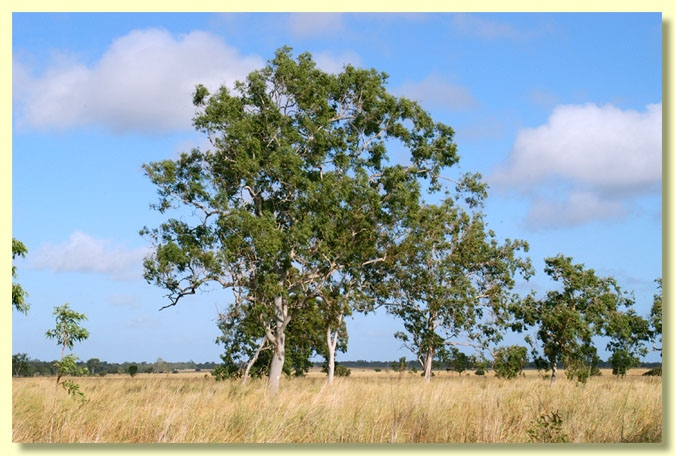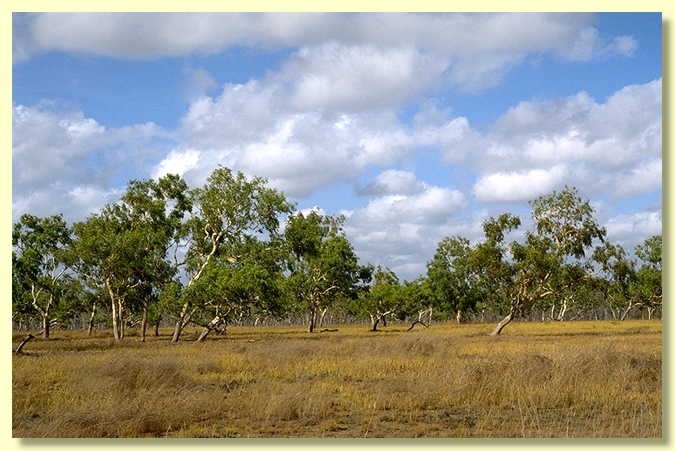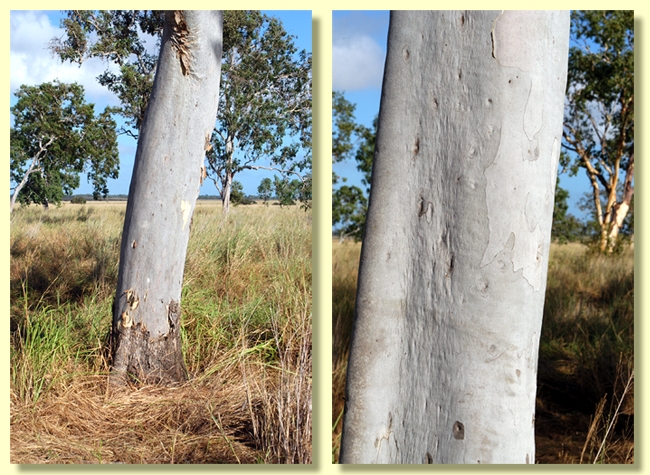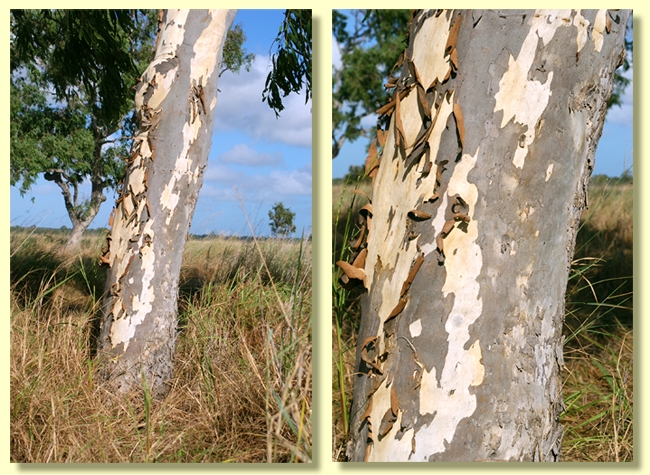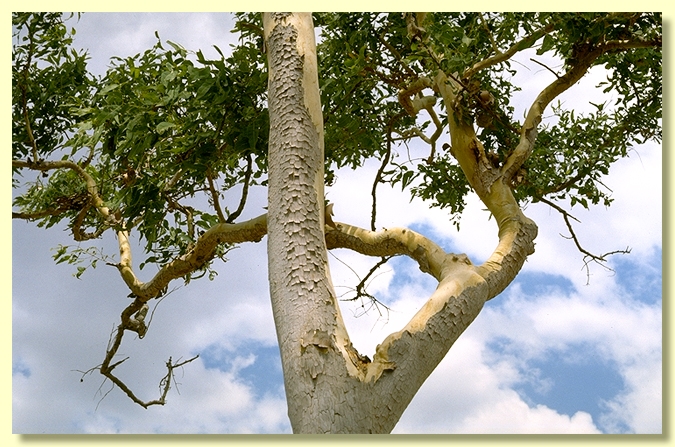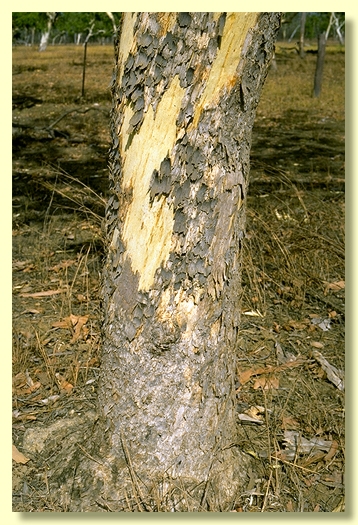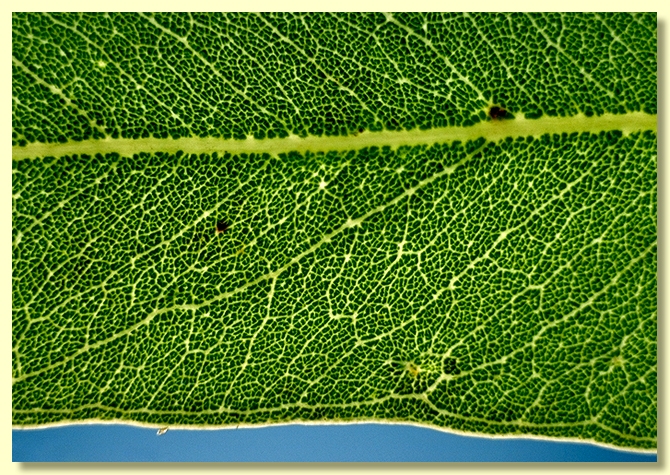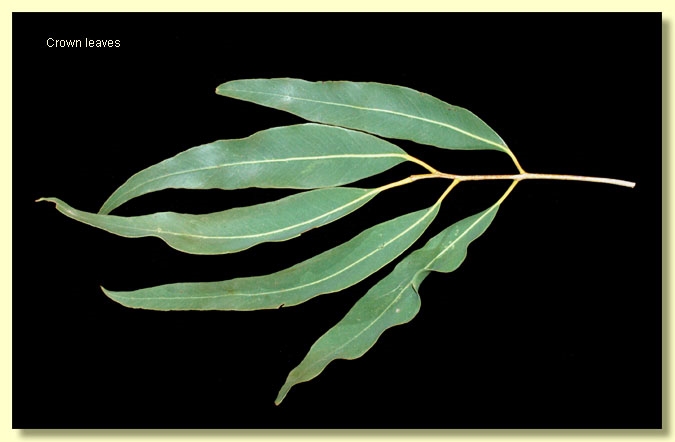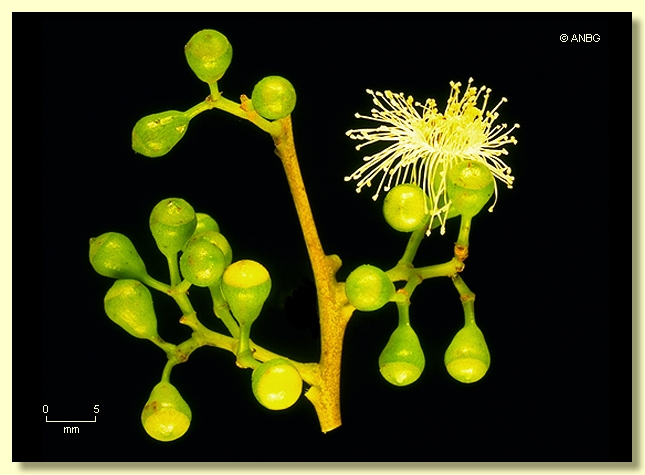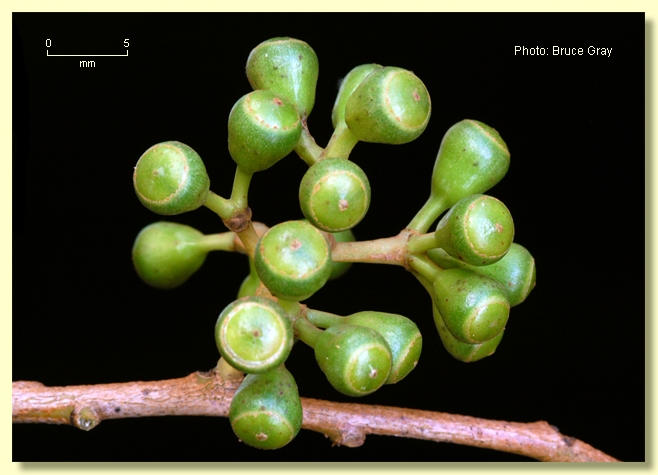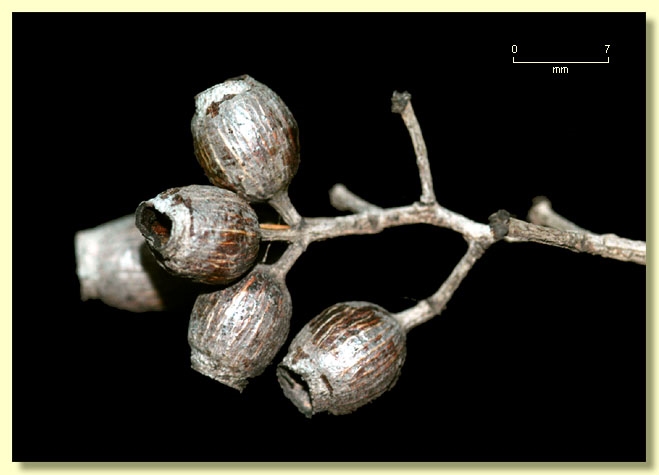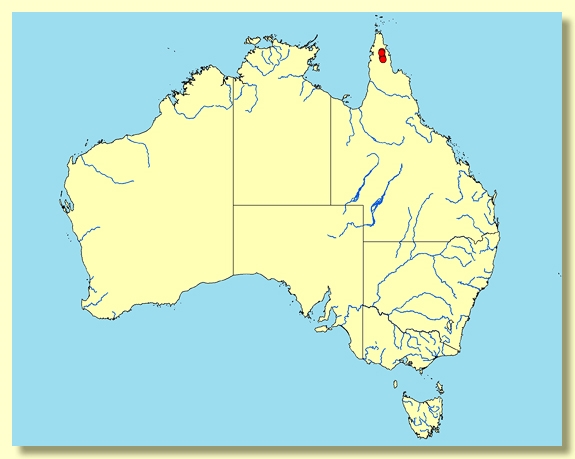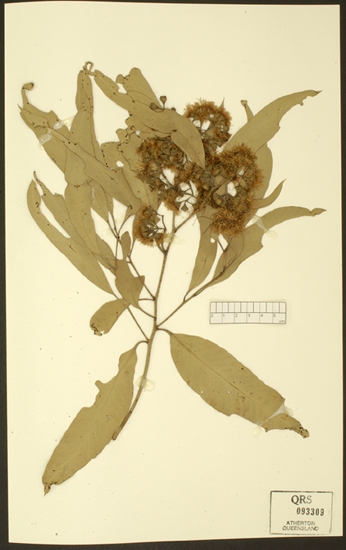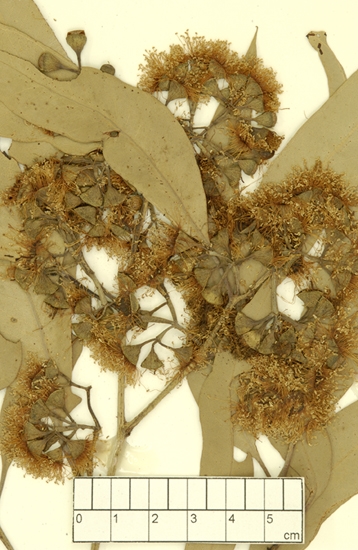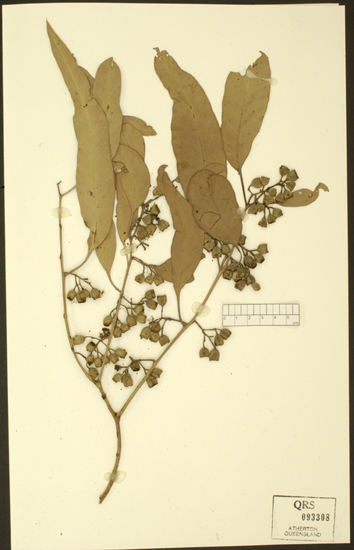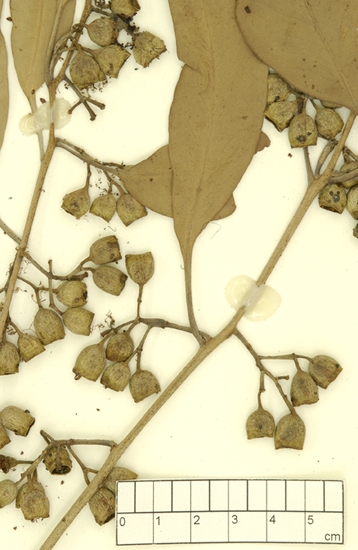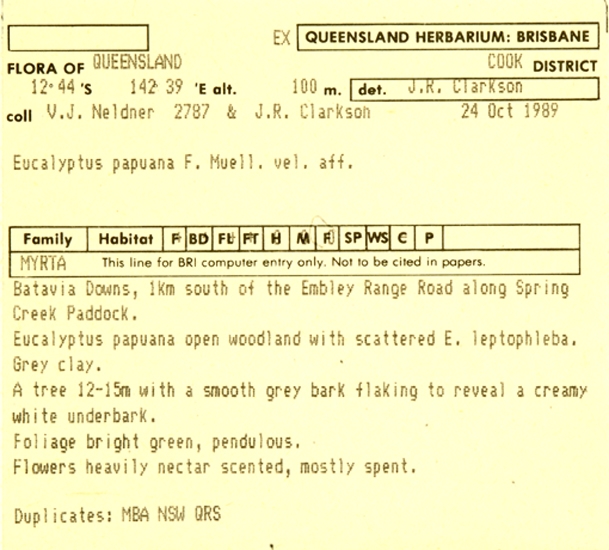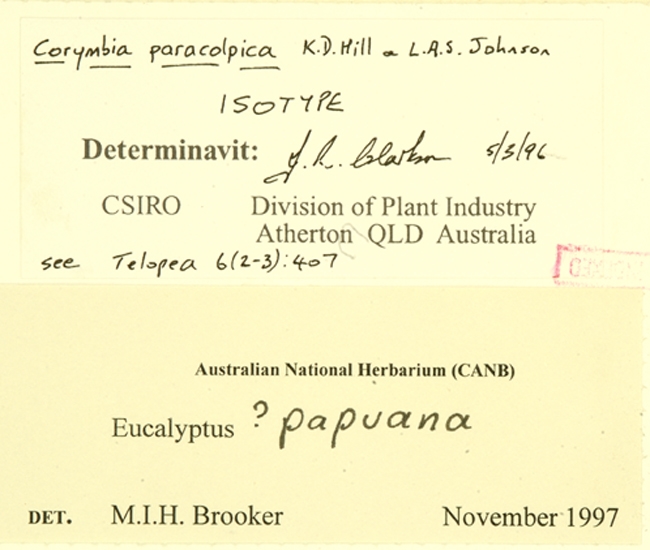Euclid - Online edition
Corymbia papuana
Corymbia | Blakearia
Corymbia papuana (F.Muell.) K.D.Hill & L.A.S.Johnson, Telopea 6: 405 (1995).
Eucalyptus papuana F.Muell., Descr. Notes Papuan Pl.1: 8 (1875). T: Opposite Yule Island on New Guinea mainland, P.Reedy 139; holo: MEL; iso: NSW (leaf only).
Eucalyptus papuana F.Muell. var. papuana, sensu M.I.H. Brooker & D.A. Kleinig "Field Guide to the Eucalypts, vol. 3", p. 50 (1994). Inkata: Melbourne.
Tree to 40 m tall. Forming a lignotuber.
Bark smooth throughout, white to creamy white or pale grey-green on newly exposed surface, sometimes with a short stocking of ± tessellated to scaly rough bark at the base of the trunk for up to ca 0.7 m.
Branchlets lack oil glands in the pith; smooth.
Juvenile growth (coppice or field seedlings to 50 cm): stems rounded in cross-section, setose with bristle-glands at least in the lowest part, in PNG specimens setae persisting for up to ca 0.5 m of growth; juvenile leaves shortly petiolate, opposite to sub-opposite or alternate, lowest leaves and newest re-sprouts smaller, elliptic-ovate, quickly becoming robustly ovate/cordate to lanceolate, 5–19 cm long, 2.2–11 cm wide, base rounded to lobed then on higher leaves base tapering to petiole, apex rounded and apiculate or pointed, margin entire or subcrenulate, green to grey-green, dull, sparsely setose or glabrous.
Adult leaves alternate, petioles 0.7–2.5 cm long; blade lanceolate, 9–21(26) cm long, 1.6–3.5(4.2) cm wide, undulate or flat, base tapering to petiole, margin entire, apex pointed, concolorous, dull, green, side-veins at about 45° to midrib, reticulation dense to very dense, intramarginal vein present, oil glands not visible.
Inflorescence axillary compound or rarely termonal to leafless branchlet, with an expanded rhachis of 2 to 5 internodes, the basal internode 0.5–1.8 cm long and subsequent internodes each 0.2 to 1.2 cm long, peduncles variable within an inflorescence, 0.2–1 cm long, buds 3 or 7 per umbel, pedicels 0.2–1 cm long. Mature buds pyriform, 0.5–0.6 cm long, 0.4–0.5 cm wide, smooth, scar present (outer operculum shed early), operculum shallowly rounded and sometimes apiculate, stamens inflexed, all fertile, anthers oblong, dorsifixed, versatile, dehiscing by longitudinal slits, style long and straight, stigma ± blunt, locules 3, the ovules irregularly arranged on the placentae. Flowers creamy white, perfumed.
Fruit pedicellate (pedicels 0.2–1 cm long), barrel-shaped or urceolate, 0.6–1.2 cm long, 0.6–0.8 cm wide, thin-walled, disc descending vertically, valves 3, enclosed.
Seeds brown, 3–4 mm wide, flattened or saucer shaped, smooth, hilum ventral.
Cultivated seedlings (measured at ca node 10): not grown.
Flowering has been recorded in October and November.
A ghost gum tree found in southern Papua New Guinea, southern West Papua, islands of Torres Strait and the northern parts of Cape York Peninsula, Queensland, Australia. It occurs as a component of savannah woodlands on flat or slightly rising ground. Corymbia papuana is predominantly smooth white-barked with or without a thin scaly rough stocking for < 0.5 m, and a crown of petiolate dull green lanceolate leaves variable in width, pedicellate buds in clusters of 3 or 7 arranged in an expanded axillary inflorescence in which 2 to as many as 5 internodes are clearly visible. Fruits, like those of all ghost gums, are thin-walled with the valves enclosed. Coppice growth is at first setose and has small elliptic-ovate leaves to only ca 6–10 cm x 2–5 cm, but subsequent coppice growth produces much larger leaves to 19 cm long and 11 cm wide, and often with a lobed or cordate to rounded leaf-base, with the setae variably persisting densely on the stem for some height or not.
C. papuana is closely related to three other ghost gum species, C. tessellaris, C. bella and C. arafurica. All four species share the expanded inflorescence arrangement, which is unlike that found in any other ghost gum species. C. tessellaris is a widespread tree of stately habit occurring in eastern Australia north of Narrabri, New South Wales, through eastern Queensland to southern Papua New Guinea, and always has a well defined stocking of clearly and regularly tessellated thick bark over 1–4 m of the trunk then abruptly giving way to smooth pale bark, and coppice growth that is glabrous and has leaves 10 cm long and to 2 cm wide; C. bella occurs from the Broome and Derby area of the Kimberley region of Western Australia east through the Top End of the Northern Territory north of Top Springs and Borroloola, in all but the highest rainfall areas, and extending around the Gulf of Carpentaria to Croydon and the lower Mitchell River in Queensland. C. bella is white-barked, rarely with any rough bark at all and has glabrous coppice growth with leaves never more than 3 cm wide and with tapering leaf-bases. The fourth species in the group, C. arafurica, is endemic to the high rainfall, more low-lying coastal areas of the Top End of the Northern Territory and is distinguished by thin scaly rough bark on the lower trunk, coppice growth with sparsely distributed setae only on lower stem and virtually glabrous lanceolate leaves to 25 cm long and 12 cm wide and with tapering or rounded leaf-bases.
Historically, most smooth-barked ghost gum trees from northern and central Australia have been called Eucalyptus papuana regardless of the type of inflorescence they possess. Hill & Johnson (1995) in their revision of the ghost gums and bloodwoods adopted a narrower concept and applied the name C. papuana to trees only found in southern Papua New Guinea and southern Irian Jaya (now West Papua), and called the trees from northern Cape York Peninsula by another new name, C. paracolpica.
The authors of EUCLID consider this Cape York tree to be synonymous with C. papuana, after recent field inspections and collections of juvenile leaves on coppice growth from that area, and comparisons with recent and not so recent herbarium collections from Papua New Guinea. In their field guide Brooker & Kleinig (1994) treat the Cape York trees as E. papuana var. papuana and the central Australian smooth-barked ghost gums as E. papuana var. aparrerinja. Brooker (2000) in his classification of the genus Eucalyptus includes E. papuana (allied with E. tessellaris and E. bella) in the taxonomic section Extensae and makes a new combination, Eucalyptus aparrerinja, for the central Australian tree (placing it in taxonomic section Abbreviatae reflecting its contracted inflorescence).
MORE ABOUT CORYMBIA
MORE ABOUT GHOST GUMS
Corymbia papuana: undoubtably a reference to "The great Papuan Island, one of the largest of the globe..." This is the start of the opening sentence of Mueller's book Descriptive Notes on Papuan Plants published in 1875, wherein he described Eucalyptus papuana. The on-line Oxford English Dictionary (http://dictionary.oed.com) states "Papua, the name originally of the island of New Guinea..." and says the word probably has a Malayan (Malay papuah, pepuah) origin, meaning frizzled, a reference to the hair of the people of Papua.

